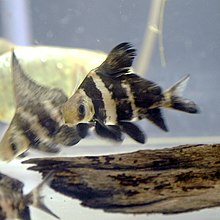| Myxocyprinus | |
|---|---|

| |
| Juveniles | |
| Scientific classification | |
| Domain: | Eukaryota |
| Kingdom: | Animalia |
| Phylum: | Chordata |
| Class: | Actinopterygii |
| Order: | Cypriniformes |
| Family: | Catostomidae |
| Subfamily: | Myxocyprininae Fowler, 1958 |
| Genus: | Myxocyprinus (T. N. Gill, 1878) |
| Species: | M. asiaticus
|
| Binomial name | |
| Myxocyprinus asiaticus (Bleeker, 1865)
| |
| Synonyms | |
| |
Myxocyprinus is a monotypic genus of freshwater fish in the monotypic subfamily Myxocyprininae within the family Catostomidae.[1][2] The only species is Myxocyprinus asiaticus, also known as the Chinese sucker.[1]
It is a popular freshwater aquarium fish[3] known under various common names, Chinese high-fin banded shark,[4] Chinese banded shark, Chinese sailfin sucker,[5] high-fin (also spelled hi-fin[6]) banded loach, high-fin loach, Chinese high-fin sucker, sailfin sucker, topsail sucker, Asian sucker, wimple carp, wimple,[5] freshwater batfish, Hilsa herring, rough fish, Chinese or Asian zebra high-fin shark, Chinese or Asian zebra high-fin sucker,[3] Chinese emperor, Siamese sucker,[7] Chinese banded shark,[8] and entsuyui in Japanese. Despite its common names, it bears no relation to real sharks.[9] It grows to about 1.35 m (4 ft 5 in) long[10] and is unsuitable for most home aquariums.[11][5]
It has declined drastically due to pollution, dams (preventing its natural breeding migration), overfishing, introduced species and collection for the aquarium trade.[11][5][9] As a consequence it has been placed on the Chinese list of endangered species and is a state protected species.[11][9]
- ^ a b Froese, Rainer; Pauly, Daniel (eds.). "Species in genus Myxocyprinus". FishBase. February 2024 version.
- ^ Eschmeyer, William N.; Fricke, Ron & van der Laan, Richard (eds.). "Myxocyprinus". Catalog of Fishes. California Academy of Sciences. Retrieved 10 August 2024.
- ^ a b Freshwater batfish, Whozoo.org, December 1999, retrieved on: August 21, 2007 Archived September 27, 2007, at the Wayback Machine
- ^ "Chinese high fin banded shark, Chinese sucker - Myxocyprinus asiaticus". Aquaticcommunity.com.
- ^ a b c d Lundie, Adam. Myxocyprinus asiaticus, Fishprofiles.com, 2007, retrieved on: August 21, 2007.
- ^ "Photos of large hi-fin shark?". AquariumCentral.com.
- ^ Chinese emperor, WhoZoo.org, 2000, retrieved on: August 21, 2007 Archived February 23, 2007, at the Wayback Machine
- ^ Chinese banded shark (Myxocyprinus asiaticus), Aqua-Fish.net, 2007, retrieved on: August 21, 2007
- ^ a b c Koga, James S. Chinese high fin banded shark Archived 2016-08-15 at the Wayback Machine, Cal Poly Pomona, September 2003. Retrieved on 21 August 2007
- ^ Cite error: The named reference
recordwas invoked but never defined (see the help page). - ^ a b c SeriouslyFish: Myxocyprinus asiaticus. Retrieved 9 May 2013
